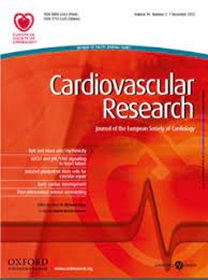Cardiac automaticity is modulated by IKACh in sinoatrial node during pregnancy
IF 10.2
1区 医学
Q1 CARDIAC & CARDIOVASCULAR SYSTEMS
引用次数: 0
Abstract
Aims Pregnant women have a significantly elevated resting heart rate (HR), which makes cardiac arrhythmias more likely to occur. Although electrical remodeling of the sinoatrial node (SAN) has been documented, the underlying mechanism is not fully understood. The acetylcholine-activated potassium current (IKACh), one of the major repolarizing currents in the SAN, plays a critical role in HR control by hyperpolarizing the maximal diastolic potential (MDP) of the SAN action potential (AP), thereby reducing SAN automaticity and HR. Thus, considering its essential role in cardiac automaticity, this study aims to determine whether changes in IKACh are potentially involved in the increased HR associated with pregnancy. Methods and Results Experiments were conducted on non-pregnant (NP, 2-3 months old) and pregnant (P, 17-18 gestation days) female CD-1 mice. IKACh was recorded on spontaneously beating SAN cells using the muscarinic agonist carbachol (CCh). Voltage-clamp data showed a reduction in IKACh density during pregnancy, which returned to control values shortly after delivery. The reduction in IKACh was explained by a decrease in protein expression of Kir3.1 channel subunit and the muscarinic type 2 receptor. In agreement with these findings, current-clamp data shows that the MDP of SAN cells from P mice were less hyperpolarized following CCh administration. Surface electrocardiograms (ECGs) recorded on anesthetized mice revealed that the cholinergic antagonist atropine and the selective KACh channel blocker tertiapin-Q increased HR in NP mice and had only a minimal effect on P mice. AP and ECG data also showed that pregnancy is associated with a decrease in beating and heart rate variability, respectively. Conclusion IKACh function and expression are decreased in the mouse SAN during pregnancy, strongly suggesting that, in addition to other electrical remodeling of the SAN, reduced IKACh also plays an important role in the pregnancy-induced increased HR.妊娠期心房结的心律受 IKACh 调节
目的 孕妇的静息心率(HR)明显升高,因此更容易发生心律失常。虽然有记录显示窦房结(SAN)发生了电重塑,但其基本机制尚未完全明了。乙酰胆碱激活的钾电流(IKACh)是 SAN 中主要的复极化电流之一,它通过使 SAN 动作电位(AP)的最大舒张电位(MDP)超极化,从而降低 SAN 的自动性和心率,在心率控制中起着至关重要的作用。因此,考虑到 IKACh 在心脏自律性中的重要作用,本研究旨在确定 IKACh 的变化是否可能与妊娠导致的心率增快有关。方法和结果 在非妊娠(NP,2-3 个月大)和妊娠(P,17-18 个妊娠日)雌性 CD-1 小鼠身上进行实验。使用毒蕈碱激动剂卡巴胆碱(CCh)在自发跳动的 SAN 细胞上记录 IKACh。电压钳数据显示,IKACh 密度在妊娠期间降低,分娩后不久恢复到对照值。Kir3.1通道亚基和毒蕈碱2型受体蛋白表达的减少解释了IKACh的减少。与这些发现一致的是,电流钳数据显示,P 小鼠 SAN 细胞的 MDP 在给予 CCh 后超极化程度较低。对麻醉小鼠记录的体表心电图(ECG)显示,胆碱能拮抗剂阿托品和选择性 KACh 通道阻滞剂 tertiapin-Q 会增加 NP 小鼠的心率,而对 P 小鼠的影响很小。AP 和心电图数据还显示,妊娠分别与心跳和心率变异性的降低有关。结论 妊娠期间小鼠 SAN 中 IKACh 的功能和表达均下降,这强烈表明除了 SAN 的其他电重塑外,IKACh 的减少在妊娠引起的心率增快中也起了重要作用。
本文章由计算机程序翻译,如有差异,请以英文原文为准。
求助全文
约1分钟内获得全文
求助全文
来源期刊

Cardiovascular Research
医学-心血管系统
CiteScore
21.50
自引率
3.70%
发文量
547
审稿时长
1 months
期刊介绍:
Cardiovascular Research
Journal Overview:
International journal of the European Society of Cardiology
Focuses on basic and translational research in cardiology and cardiovascular biology
Aims to enhance insight into cardiovascular disease mechanisms and innovation prospects
Submission Criteria:
Welcomes papers covering molecular, sub-cellular, cellular, organ, and organism levels
Accepts clinical proof-of-concept and translational studies
Manuscripts expected to provide significant contribution to cardiovascular biology and diseases
 求助内容:
求助内容: 应助结果提醒方式:
应助结果提醒方式:


